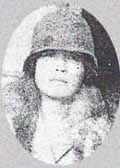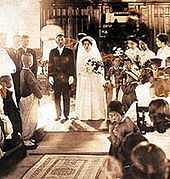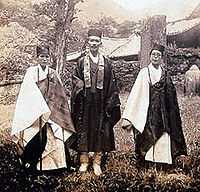Na Hye-sok
| Na Hye-Sok | |
|---|---|
 | |
| Born |
18 April 1896 Suwon, Gyeonggi, South Korea |
| Died |
10 December 1948 (aged 52) Seoul, South Korea |
| Occupation | Poet, journalist, writer, painter |
| Nationality | Korean Empire, Korea |
| Period | 1896-1948 |
| Genre | Poetry, novel, art, paint, essay, drama |
| Na Hye-sok | |
| Hangul | 나혜석 |
|---|---|
| Hanja | 羅蕙錫 |
| Revised Romanization | Na Hye-seog |
| McCune–Reischauer | Na Hye-sŏk |
| Pen name | |
| Hangul | 정월 |
| Hanja | 晶月 |
| Revised Romanization | Jeongwol |
| McCune–Reischauer | Jungwol |
| Courtesy name | |
| Hangul | 명순 |
| Hanja | 明順 |
| Revised Romanization | Myungsun |
| McCune–Reischauer | Myungsoon |
Na Hye-sok (Hanja: 羅蕙錫, Hangul: 나혜석, 18 April 1896 – 10 December 1948) was a Korean poet, feminist writer, painter, educator, and journalist.[1] Her pen name was Jeongwol (Hangul: 정월, 晶月).[2]
She was the first female Korean artist of Western painting and the second Korean artist who held an oil painting exhibition. She became well known as a feminist with her criticism against the marital institution in the early 20th century.
Early life
Na Hye-Sok was born in 1896 in Suwon, Gyeonggi Province, as the fourth child of a wealthy family. She was called Agi (Hangul: 아기) and Myeong-soon (Hangul: 명순) in her childhood. Hye-sok is the name given to her when she started attending Jin Myeong Girl's High School. Na demonstrated her artistic talent from an early age and graduated at the top of her class at Jin Myeong Girl's High School in 1913.[3] Encouraged by her brother, Na entered Tokyo Women's Art College in Japan and studied western painting, which was thought impossible for a woman in male-centered Joseon society.
Career
Na Hye-sok (1896–1948) was a pioneering Korean feminist writer and painter. She was the first female professional painter and the first feminist writer in Korea.[4] She created some of the earliest Western paintings in Korea, and published feminist novels and short stories.[5][6] Her major written work, Kyonghui (Hangul: 경희), published in 1918, concerns a woman's self-discovery and her subsequent search for meaning in life as a "new woman;" it is the first feminist short story in Korean literature.[6][7]

After her graduation from Jin Myeong Girls' High School in 1913, Na majored in Western oil painting at Tokyo Arts College.[8] In April 1915, Na became the main organizer of the Association of Korean Women Students in Japan. It was around this time that she fell in love with Ch'oe Sung-gu, a student at Keio University and the then editor and publisher of the magazine Hakchigwang. The relationship between Na and Ch'oe was highly publicized among Korean students in Japan, as was Na's close literary and personal association with Yi Kwang-su. In the spring of 1915, Na's father summoned her back home and pressured her to accept a marriage proposal from a well-established family; Na was able to escape this by finding a teaching position in a primary school, according to her later account. After a year of teaching and saving money for her tuition, Na returned to Tokyo toward the end of 1915 to resume her studies. In April 1916, however, Ch'oe Sung-gu died of tuberculosis, and Na had to temporarily stop her studies while recovering from a mental breakdown.[7]

In 1920, Na Hye-sok, along with Kim Won-ju and ten men, established the literary magazine P-yeho.[9] Early in the 1920s, both Kim and Na contributed a series of articles to the first magazine for Korean women, called "Sinyoja" ("New Woman"), on the subject of improving Korean women's clothing. They argued for a more functional and practical outfit for Korean women to help improve their hygiene, health, and self-image, and denounced traditional Korean dresses which were designed with no consideration for women's physical comfort, protection, and convenience.[8]
On April 10, 1920, she was married to Kim Woo-young, in Jeongdong wedding hall, Seoul. Theirs was a love marriage, rare at the time in Korea.
In 1927 Na Hye-sok and her husband went on a three-year tour of Europe. While in Paris, with her husband away, she is said to have engaged in an affair with Cheondo-gyo leader Choi Rin, which became fodder for gossip columnists. Na Hye-sok's husband divorced her on grounds of infidelity in 1931.[5][8] It is not known whether she truly was unfaithful; her diary shows that up to her late 1930s she tried hard to remain loyal to traditional Korean wifely and maternal roles in spite of the many humiliations and frustrations of her unhappy marriage. In any case, she came to be thought of and stigmatized as a woman who used her artistic pretensions as an excuse for sexual abandon.
Despite the divorce and disgraceful reputation, Na continued painting and won a special prize at the 10th Joseon Art Exhibition in 1931. She also published a piece called “A Divorce Confession” in the Samcheolli magazine in 1934, raising issues with gender inequality endorsed by Korean morality and tradition. She challenged the patriarchal social system and male-oriented mentality of Korean society at the time.
She died alone on December 10, 1948 at a hospital for vagrants. Having had no one to care for her in the later days, the location of her grave is still unknown.[10] Her fate was often used to scold young Korean woman who had literary or artistic ambitions; "Do you want to become another Na Hye-sok?" was a frequent reprimand to daughters and younger sisters.[5][11] However, she has recently been acknowledged in Korea for her artistic and literary accomplishments. For example, Seoul Arts Center opened a retrospective exhibition of her works in 2000.[5]
Works
- Divorce testimony (이혼고백서, 離婚告白書)
- Go on a honeymoon, the tomb of first love (첫사랑의 무덤으로 신혼여행을 가다)
- Gyunghee (경희)
- Jeongsun (정순)
- Kyonghui (At Highbeam, so requires subscription. In English.)
- Na Hye-sok Jeonjip (나혜석전집, 羅蕙錫全集)
- Na Hye-sok Works Collection(나혜석 작품집)
Works in Translation
- Kyeonghui in Questioning Minds: Short Stories By Modern Korean Writers (p. 24)
| Wikisource has original text related to this article: |
See also
|
|
External links
- 羅蕙錫 (Japanese)
- Times Weekender; Na Hye-Sok Lived Flamboyant Life to Tragic End. - Korea Times (Seoul, Korea) | HighBeam Research - FREE trial
- Creating new paradigms of womanhood in modern Korean literature: Na Hye-sok's "Kyonghui".(Critical Essay) - Korean Studies | HighBeam Research - FREE trial
- Most Feminine and Feminist
References
- ↑ "Na Hye-sok" LTI Korea Datasheet available at LTI Korea Library or online at: http://klti.or.kr/ke_04_03_011.do#
- ↑ The bright moon
- ↑ Kim, H. J. (2002). The life and paintings of Rah, Hye-Suk. (Masters Thesis). Kyonggi University, South Korea.
- ↑ Places at the Table - Institute of East Asian Studies, UC Berkeley
- ↑ 5.0 5.1 5.2 5.3 Times Weekender; Na Hye-Sok Lived Flamboyant Life to Tragic End. - Korea Times (Seoul, Korea) | HighBeam Research - FREE trial
- ↑ 6.0 6.1 Korean Studies, Volume 26 - Table of Contents
- ↑ 7.0 7.1 Creating new paradigms of womanhood in modern Korean literature: Na Hye-sok's "Kyonghui".(Critical Essay) - Korean Studies | HighBeam Research - FREE trial
- ↑ 8.0 8.1 8.2 http://eng.buddhapia.com/_Service/_ContentView/ETC_CONTENT_2.ASP?PK=0000594132&danrak_no=&clss_cd=0002134733&top_menu_cd=0000000808
- ↑ Chronology of women's history - Google Books
- ↑ KBS World. "Koreans in History". Retrieved April 2011.
- ↑ Most Feminine and Feminist